JWF Fund 2019
Japan Water Forum (JWF) Fund managed through corporate and individual membership fee and donations is the initiative that supports grass-roots organizations to address water-related issues in developing countries. The JWF Fund will be held for the 15th time since its establishment in 2005.
In the JWF fund 2019, we have received 302 applications from 36 countries.
As a result of selection, we have decided to provide funds for 7 projects from 6 countries.
Outline of the application
・Application Period: 3 June to 15 July
・Number of the applications: 302 from 36 countries
・Selected projects: 7 projects from 6 countries; Papua New Guinea (1), Uganda (2), Kenya (1), South Sudan (1), Haiti (1) and Sierra Leone (1)
The projects were selected and decided among 302 applications by screening of JWF staffs.
Recipients of JWF Fund 2019
*The following text is basically taken from their application forms and were written by the organization themselves.
1.Improving and sustaining village water supply in Lababia (Papua New Guinea)
Outline of the project
・Organization: Morobe Development Foundation Inc. (#255)
Morobe Development Foundation (MDF) is a community-based organization located in Lae Morobe Province, Papua New Guinea. For over 10 years, MDF has worked closely with communities to improve quality of life, provide education and increase engagement related to social issues.
・Country/Area: Papua New Guinea/ Morobe Province
・Project period: October 2019 to February 2020
・Number of expected beneficiaries (Direct): 800 people
・Cost: USD 2,154 (JWF Fund USD 1,000, contribution from beneficiaries USD 59.11, Morobe Development Foundation Inc. USD 147.78 and District Authority USD 295.55)
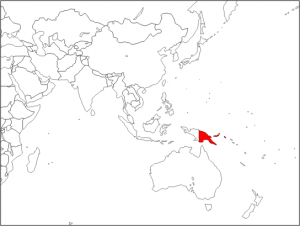 |
| Papua New Guinea |
Background
The target village, Lababia, is the largest village under the local level government Salamaua, the south coast of the Huon District. It is a picturesque tropical island with long sand beaches and clear blue waters.
Lababia geographically sits where high occurrence of typhoons traverses, and rains brought by typhoons result in heavy flooding. In 2016, a strong typhoon hit the area and brought devastation to the bio-physical landscapes of the community including local sources of freshwater for drinking and domestic uses. Since then, the villagers have to travel 2 hours by boat to fetch water for their day to day living.
The very restricted access to freshwater takes it’s toll on public health, resulting in cases of diseases such as diarrhea, typhoid, malaria and cholera. There was also a landslide and flood in 2016 at Lababia Village destroying food gardens, the natural flora and fauna as well as the water supply system for the village.
There were no government support to install the water supply and with the community school located in the village, it is necessary to construct the water supply to ensure the children have access to quality water in reasonable quality.
Contents of the project
– Consultation and action planning workshop
– Awareness and education activities
– Training on WASH*
– Bio-physical examination of water
– Training on installation, monitoring and preventive maintenance of water hand pumps
– Construction and installation of water hand pumps
– Setting up community-led monitoring
– Evaluation system and Project evaluation
*WASH: Water and Sanitation and Hygiene
Expected outcomes
– Community members will have improved water quality, and consequently better sanitation and hygiene practices; thereby better health standards.
– Community members are skilled and empowered to manage their own water supply system creating responsive and responsible community collaborative efforts.
– Steady availability of and access to safe water is enabled and sustained for the community, saving time and effort. This further increases its daily productivity e.g. farming and fishing.
Current situation of the project site
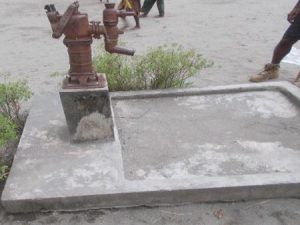 |
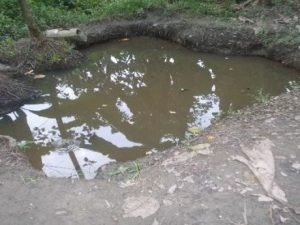 |
| Damaged water pump due to rusting | An open water well where the community fetches water for domestic purposes |
2.Reconstruction of Kyageefa Water spring in Kikaada village (Uganda)
Outline of the project
・Organization: Rural Aid Foundation (RAFO) (#229)
Rural Aid Foundation (RAFO) was founded originally as a rural community support, research, advocacy and a social integral platform between refugees and Ugandan rural host communities in Kyangwali refugee settlement in Western Uganda in 2013.
・Country/Area:Uganda/ Kibaale district
・Project period: October 2019 to February 2020
・Number of expected beneficiaries (Direct): 1,500 children
・Cost: USD 1,228 (JWF Fund USD 1,000, contribution from beneficiaries USD 128 and RAFO USD 100)
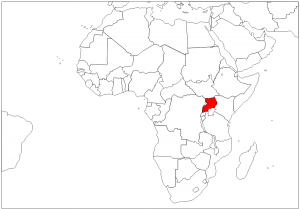 |
| Uganda |
Background
Kikaada primary school is a government aided school in Kikaada village, Kibaale district. It has a population of 1500 pupils/children aged between 5 years and 17 years. Kyageefa water spring has been the only source of water for this school, the neighboring trading center which has 400 households (about 1000 residents) and the Kikaada market which takes place every Saturday and Sunday. Kyageefa water spring stopped operating after a heavy rain in March 2019 that resulted into the dragging of stones and soil that blocked the spring. This has forced children from Kikaada primary school to walk over 3 kilometers to look for water from a pond in Kabode village. To acerbate the situation, this pond is also used a distillation center for local alcohol (Waragi from sugar canes) and alcohol residue is damped this pond. Since March 2019, 60 cases of bilharzia and 56 typhoid cases have been recorded at Kibaale health center according to the health center report. Since this pond is also shared by other Kikaada residents, there as usually long queues that have even made children miss classes. This pond is also shared with animals (cattle) from the neighbors.
Contents of the project
– Hold project Inception meeting with stakeholders.
– Identify, establish and train a 13-members water management committee.
– Kyageefa water spring will be re-constructed.
– Holding on site water treatment and boiling demonstrations
– Hold one radio show to sensitize community on the roles and responsibilities of the water management committee.
Expected outcomes
– Improved health of children and improved learning of children.
– Reduced burden of water borne diseases among children and the Kikaada community.
– A well maintained water spring for continued water supply for children and Kikaada community.
Current situation of the project site
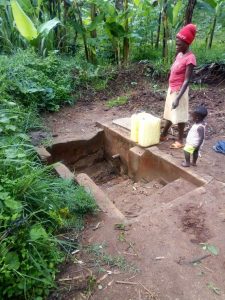 |
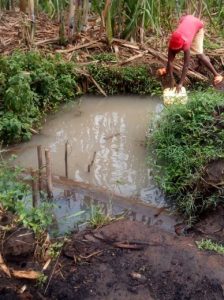 |
| Current state of Kyageefa water spring | Pond used for drinking water and distillation center |
3.Construction and protection of Kogoma spring (Kenya)
Outline of the project
・Organization: Eco-Friendly Self Help Project (#239)
The organization was established in April 2019 and works under the mission of undertaking functional activities with meaningful steps towards alleviating poverty and realizing sustainable development.
・Country/Area: Kenya/ Siaya county
・Project period: October 2019 to February 2020
・Number of expected beneficiaries (Direct): 1,721 people (410 Women, 325 men and 986 children)
・Cost: USD 1,213 (JWF Fund USD 1,000, contribution from beneficiaries USD 180 and Eco-Friendly Self Help Project USD 33)
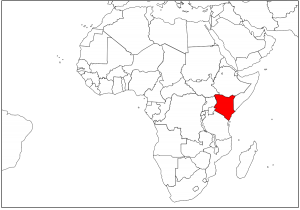 |
| Kenya |
Background
Ligoma village is a densely populated area, with majority of the villagers living below the poverty line and therefore, piped water is a pipe dream to them. There are high incidences of poor health, nutrition and sanitation (personal and environmental hygiene & management). Poor management of available resources like springs (water sources), land, manure and human waste. Human and livestock excrement and manure get into the open spring water due the fact that children defecate within the spring environ, people do their washings at the spring. Therefore 90% of the population living in Ligoma village has no access to safe water. Each villager strives to fetch water for domestic use very early in the morning before the water changes its colour, because people (including Ligoma primary school pupils) fetch water using all sorts of containers; some contains washing detergents, oils and other dirt which contaminates Kogoma spring water. These have resulted into high prevalence of water and sanitation related ailments like amoeba, dysentery, diarrhea, typhoid, cholera and bilharzia.
Approximately 80% of hospital attendance in the nearby Mutumbu Dispensary is related to water, sanitation and hygiene.
Contents of the project
– Kogoma spring water construction and fencing.
– First meeting (At the chief’s office – Mutumbu)
– Second meeting (at Ligoma primary School- 80 metres from the project site)
– Third meeting (at the project site)
– Fourth meeting will be at the project site immediately after the completion of the project.
Expected outcomes
– Increased access and utilization of safe drinking water
– Adequate household and environmental sanitation
– Safe hygiene practices in household and Ligoma primary school
– Reduced occurrence of water-borne diseases
– Reduced expenses on water related ailments.
– Reduced conflicts since water will be gushing out through pipe and not open water where one can fetch water using a dirty container that is provoking.
Current situation of the project site
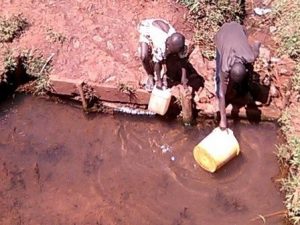 |
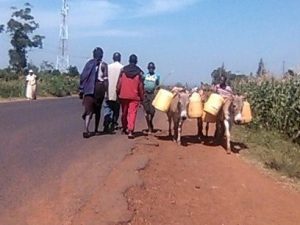 |
| Villagers fetching water at the spring | Villagers ferrying water from the spring |
4.Provision of improved access to WASH services to mitigate GBV cases among school children and vulnerable host and returnee individuals in Belle Payam, Bungu County of Central Equatoria State in South Sudan (South Sudan)
Outline of the project
・Organization: WEALTH HEALTH AND EDUCATION FOR EMPOWERED LIFE (WHEEL) SOUTH SUDAN (#210)
Wealth Health and Education for Empowered Life (WHEEL) South Sudan is a National non-governmental organization that aims at improving the health and education status of children across South Sudan. The vision of WHEEL is to create a self-reliant society that is healthy, resilient and prosperous. The mission that guides WHEEL is to facilitate equitable development through improved health, support for livelihoods and vocational education in South Sudan.
・Country/Area: South Sudan/ Central Equatoria State
・Project period: October 2019 to March 2020
・Number of expected beneficiaries (Direct): 2,000 people (819 Women, 333 men and 848 children)
・Cost: USD 1,192 (JWF Fund USD 992 and contribution from WHEEL USD 200)
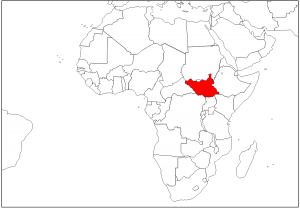 |
| South Sudan |
Background
WHEEL conducted 3-day assessment during 1st-3rd June 2019 in Bungu County, and found out that Belle Village of more than 2,000 individuals has only one borehole fixed with a hand pump which is nonfunctional. The community members drink water from an open stream ever since they returned in April 2019 from displacement that resulted from the occurrence of September 2016 conflict. Belle village borehole is located next to Belle Village Primary School which depended on it as their main source of water before September 2016 conflict. 848 school going children depend on a nearby stream for water which is exposed to fecal contamination and unsafe. On undertaking bacteriological test of a water sample from the stream E.coli was got to be positive, which confirmed data obtained from Belle Primary Health Care Center (PHCC) that, “70% of diseases in these community is diarrhea, typhoid and least is malaria” which is highly attributed to unsafe water from the stream used by the community for drinking and cooking food.
Contents of the project
– Inception of the Project with the State Stake holders
– One borehole will be repaired.
– One Village water user management committee consisting 7 members will be formed and trained.
– One hand pump technician will be trained.
– Progressive Monitoring
– Joint Monitoring of Project
– Project Evaluation
Expected outcomes
– Community in Belle Village have access to sufficient clean and safe water supply within 15 Liter sphere standard per person/day.
– Community have reduced expense cost of treating WASH related diseases.
– Community can operate and maintain their own borehole.
Current situation of the project site
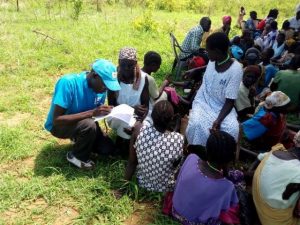 |
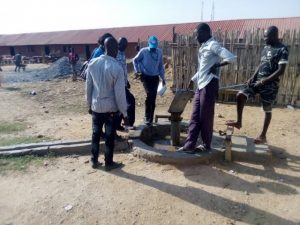 |
| WHEEL staff taking household registration in Belle village in Bungu district. |
Assessment team and Village water director checking Belle Village borehole. |
5.HAS Water System Renewal – Community Fountains (Haiti)
Outline of the project
・Organization: Hôpital Albert Schweitzer Haiti (#263)
The mission of Hôpital Albert Schweitzer Haiti (HAS) is to collaborate with the people of Haiti’s Artibonite Valley as they strive to improve their health and quality of life. HAS has provided integrated hospital and community-based healthcare to 350,000 people in a 610 square mile service area since 1956.
HAS serves in rural Haiti where there are no public utility services provided by the government. Since opening its doors, HAS has been responsible for generating all of the water, waste management and power resources needed to operate the hospital.
・Country/Area: Haiti/ Artibonite region
・Project period: October 2019 to January 2020
・Number of expected beneficiaries (Direct): 30,000 people
・Cost: USD 6,260 (JWF Fund USD 1,000, contribution from beneficiaries USD 1,000 and HAS USD 4,260)
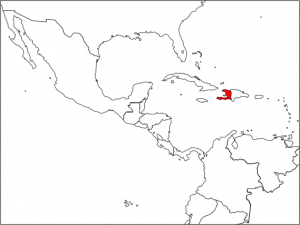 |
| Haiti |
Background
HAS’ water system is vitally needed and was in danger of becoming non-operational without significant repairs after 60+ years of hard use. HAS commissioned a Water System Analysis in 2018 including a multi-phase plan to remediate and modernize HAS’ water system.
The water system was experiencing leaks due to corrosion of galvanized piping and reduced flow rates from build-up of mineral deposits and bio-slime. The 55,000-gallon water tank was leaking heavily and needed repairs. Only three of five wells on the property were operational.
Contents of the project
– Design /Drawings/ Layouts
– Rehabilitate five community fountains.
– Involve community members in project implementation.
Expected outcomes
– Reduce consumption of contaminated water and resulting water-borne illness.
– Control and saving the natural resource will reduce costs of processing the potable water.
– Empower community members with training on how to maintain the community fountains.
Current situation of the project site
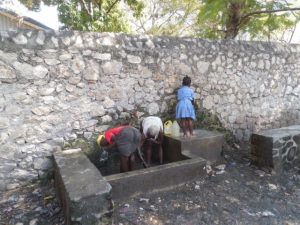 |
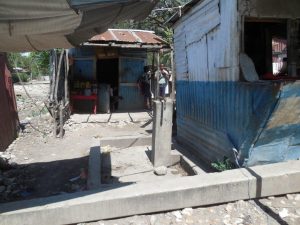 |
| Fetching water in a community fountain at HAS | Fountain in disrepair at Deschapelles |
6.Rehabilitation of a hand pump well in Baoma Village, Kpaka Chiefdom, Pujehun District, Southern Sierra Leone (Sierra Leone)
Outline of the project
・Organization: Rural Agency for Community Action Programme (RACAP/SL) (#227)
RACAP-SL is a registered Community Based Organization established since 2008 with the following mission; to support sustainable improvement in the livelihood situations and living conditions of women, men, girls and boys in remote rural areas of Southern and Eastern Sierra Leone.
RACAP/SL’s interventions are mainly in the sectors of Water, Sanitation and Hygiene (WASH), Livelihoods, Women and Girls’ Empowerment and Pro-Poor Advocacy.
・Country/Area: Sierra Leone/ Southern Province
・Project period: October 2019 to February 2020
・Number of expected beneficiaries (Direct): 800 people
・Cost: USD 1,454 (JWF Fund USD 1,000, contribution from the beneficiaries USD 254, from RACAP/SL USD 200)
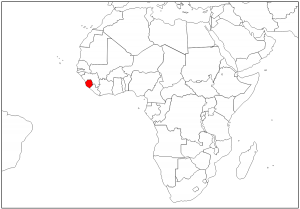 |
| Sierra Leone |
Background
Baoma village like many rural villages in Pujehun District is faced with the challenge of lack of clean drinking water. Essential Government services like are inadequate or in some villages non-existent. In 2014, UNICEF through RACAP/SL facilitated the construction of a hand pump to ease the challenge, however, this hand pump has broken down and needs urgent repairs. Also, at the peak of the dry season, the well dries up completely. Thus, the residents of Baoma including women and children rely on a running stream located approximately a mile away from the village as their main source of water for all purposes. This water source is unsafe, unprotected and exposes the villagers to many water-related problems.
Women and children are exposed to diarrhea, dysentery and typhoid which have been reported by the Pujehun District Health Management Team (DHMT) as highly prevalent in Baoma. Children are also mainly affected by skin infections like scabies when they use the water for bathing. Additionally, children who walk to the stream to fetch water run the risk of being beaten by a snake as the foot path leading to the stream is often bushy.
Contents of the project
– Conduct Project Inception Meeting.
– Restructure and train water management committee.
– One hand pump will be rehabilitated.
– The officials of the District Water Directorate will conduct water quality test.
– Hold Monthly Community Awareness Creation Sessions.
– Carry out project monitoring and oversight.
Expected outcomes
– 600 villagers from Baoma have increased knowledge and skills on water and sanitation issues and are able to maintain the rehabilitated water well for long term sustainability.
– Community by-laws developed to regulate the use of the repaired water well.
– Reduction in the prevalence of water related problems (diarrhea, dysentery & typhoid) in the Baoma village leading to a healthy, productive and active population engaging in viable economic activities to improve their living standards.
Current situation of the project site
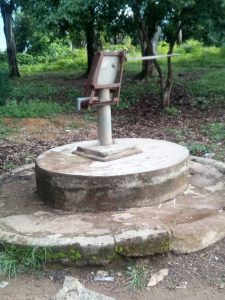 |
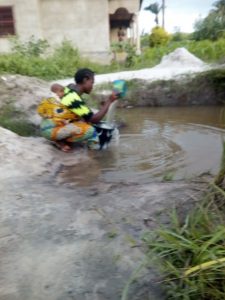 |
| Damaged hand pump well to be rehabilitated |
A suckling mother fetching water from an unprotected source |
7.Appropriate rural water and hygiene infrastructures (Uganda)
Outline of the project
・Organization: Agoro Community Development Association (ACDA) (#292)
Agoro community development association is a grassroots organization that function to empower rural community of post conflict northern Uganda’s District of Lamwo with live skills and livelihood support, and focus on preventing violence against women and girls.
・Country/Area: Uganda/ Lamwo District
・Project period: October 2019 to February 2020
・Number of expected beneficiaries (Direct): 280 people (50 Women, 30 men and 200 children)
・Cost: USD 2,139.4 (JWF Fund USD 1,000 , contribution from the beneficiaries USD 289.4 and ACDA USD 850)
 |
| Uganda |
Background
Agoro Sub-county is one of the remotest and under developed area of the northern Uganda. The basic social and economic infrastructures are still under-developed and people face challenges in re-constructing their lives after the two decades of civil war. The area is also home to thousands of refugees and asylum seekers fleeing conflict from neighboring South Sudan. Access to clean water and sanitation facility is in its worst state with more than 80% of the community and schools having limited to no access to clean water and sanitation facilities. Two boreholes and one rainwater harvesting tank in-school found in this area are non-functional as the community did not take care of them thinking that the humanitarian agencies that built them during the Camp would come back and repair them.
The situation has been made worst by the fact that Many people living in area still practice open defecation along the Okura stream; the main source of water supply; fueled by the believe that it is not culturally acceptable for faeces to pile on top of the other. The practice put the lives of the community to a range of diseases including diarrheal disease, typhoid, trachoma, skin diseases etc.
Contents of the project
– Community mobilization and inception meeting
– Renovating of the 2 rainwater harvesting tanks
– Repairing of the broken borehole
– One training session targeting village water committee
– Formation of community
Expected outcomes
– Increased access and utilization of safe drinking water.
– Reduced water related diseases such as diarrheal disease, typhoid, trachoma, skin diseases.
– Community people will be empowered to operate and maintain their own water supply facilities.
Current situation of the project site
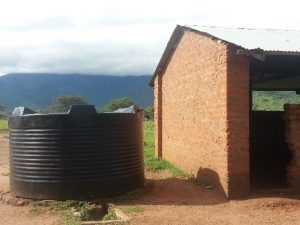 |
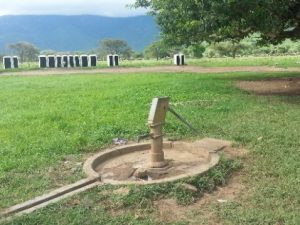 |
| RWHT with missing gutter, tape and drainage canal |
school non-functioning borehole |
(Reported by Shigenori Asai, Director and Akie Gunji, Assistant Manager)
